The Intel Comet Lake Core i9-10900K, i7-10700K, i5-10600K CPU Review: Skylake We Go Again
by Dr. Ian Cutress on May 20, 2020 9:00 AM EST- Posted in
- CPUs
- Intel
- Skylake
- 14nm
- Z490
- 10th Gen Core
- Comet Lake
CPU Performance: Rendering Tests
Rendering is often a key target for processor workloads, lending itself to a professional environment. It comes in different formats as well, from 3D rendering through rasterization, such as games, or by ray tracing, and invokes the ability of the software to manage meshes, textures, collisions, aliasing, physics (in animations), and discarding unnecessary work. Most renderers offer CPU code paths, while a few use GPUs and select environments use FPGAs or dedicated ASICs. For big studios however, CPUs are still the hardware of choice.
All of our benchmark results can also be found in our benchmark engine, Bench.
Crysis CPU Render
One of the most oft used memes in computer gaming is ‘Can It Run Crysis?’. The original 2007 game, built in the Crytek engine by Crytek, was heralded as a computationally complex title for the hardware at the time and several years after, suggesting that a user needed graphics hardware from the future in order to run it. Fast forward over a decade, and the game runs fairly easily on modern GPUs, but we can also apply the same concept to pure CPU rendering – can the CPU render Crysis? Since 64 core processors entered the market, one can dream. We built a benchmark to see whether the hardware can.
For this test, we’re running Crysis’ own GPU benchmark, but in CPU render mode. This is a 2000 frame test, which we run over a series of resolutions from 800x600 up to 1920x1080. For simplicity, we provide the 1080p test here.
This is one of our new benchmarks, so we are slowly building up the database as we start regression testing older processors.
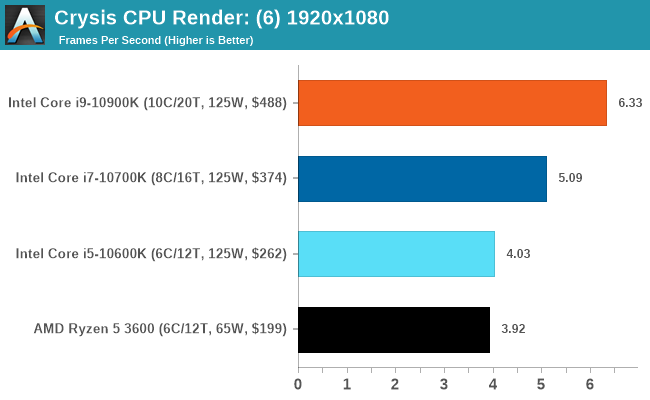
The Core i9-10900K scores 15 FPS at 800x600, which is just about playable.
Corona 1.3: Performance Render
An advanced performance based renderer for software such as 3ds Max and Cinema 4D, the Corona benchmark renders a generated scene as a standard under its 1.3 software version. Normally the GUI implementation of the benchmark shows the scene being built, and allows the user to upload the result as a ‘time to complete’.
We got in contact with the developer who gave us a command line version of the benchmark that does a direct output of results. Rather than reporting time, we report the average number of rays per second across six runs, as the performance scaling of a result per unit time is typically visually easier to understand.
The Corona benchmark website can be found at https://corona-renderer.com/benchmark
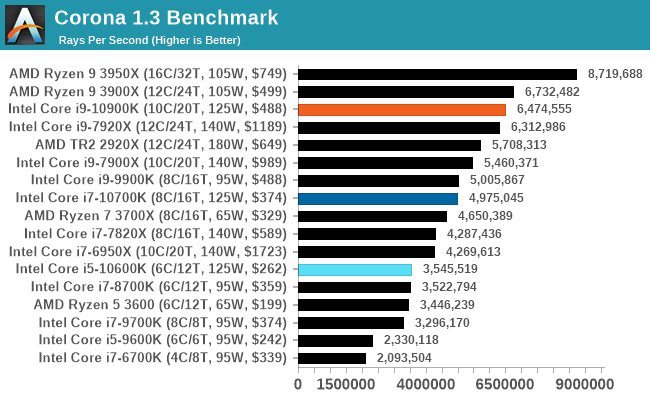
Blender 2.79b: 3D Creation Suite
A high profile rendering tool, Blender is open-source allowing for massive amounts of configurability, and is used by a number of high-profile animation studios worldwide. The organization recently released a Blender benchmark package, a couple of weeks after we had narrowed our Blender test for our new suite, however their test can take over an hour. For our results, we run one of the sub-tests in that suite through the command line - a standard ‘bmw27’ scene in CPU only mode, and measure the time to complete the render.
Blender can be downloaded at https://www.blender.org/download/
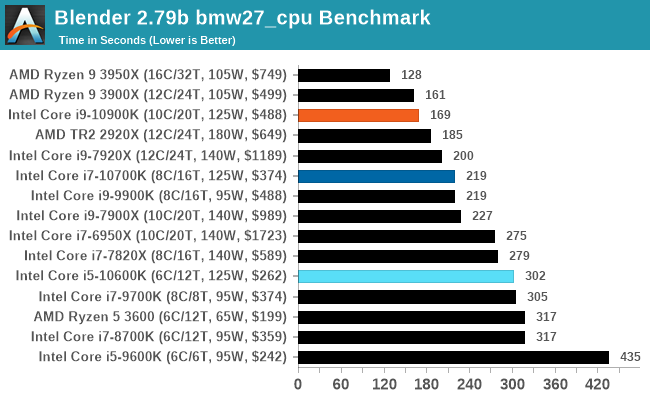
V-Ray
We have a couple of renderers and ray tracers in our suite already, however V-Ray’s benchmark came through for a requested benchmark enough for us to roll it into our suite. We run the standard standalone benchmark application, but in an automated fashion to pull out the result in the form of kilosamples/second. We run the test six times and take an average of the valid results.
This is another one of our recently added tests.
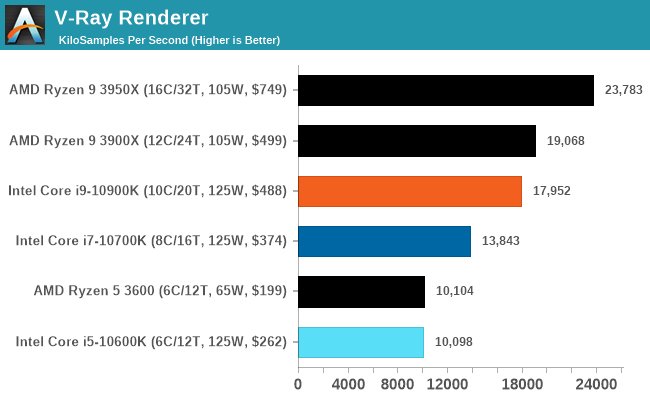
POV-Ray 3.7.1: Ray Tracing
The Persistence of Vision ray tracing engine is another well-known benchmarking tool, which was in a state of relative hibernation until AMD released its Zen processors, to which suddenly both Intel and AMD were submitting code to the main branch of the open source project. For our test, we use the built-in benchmark for all-cores, called from the command line.
POV-Ray can be downloaded from http://www.povray.org/
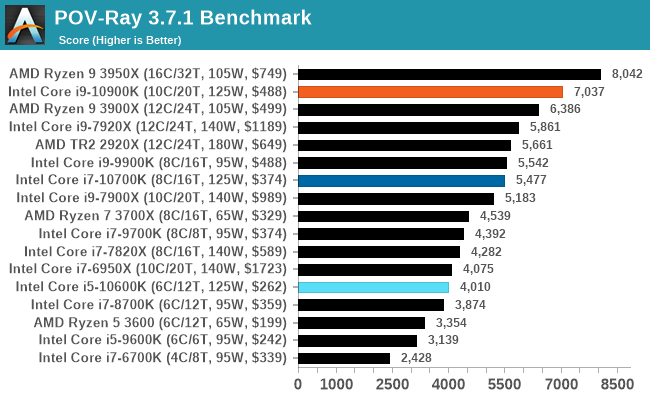
Interestingly the Core i9 with only 10C outperforms the 12C Ryzen 9 3900X here, likely due to the higher sustained frequency of the Intel chip. We clocked 220W on our Intel chip for this test however, well beyond the 120W of the AMD processor.


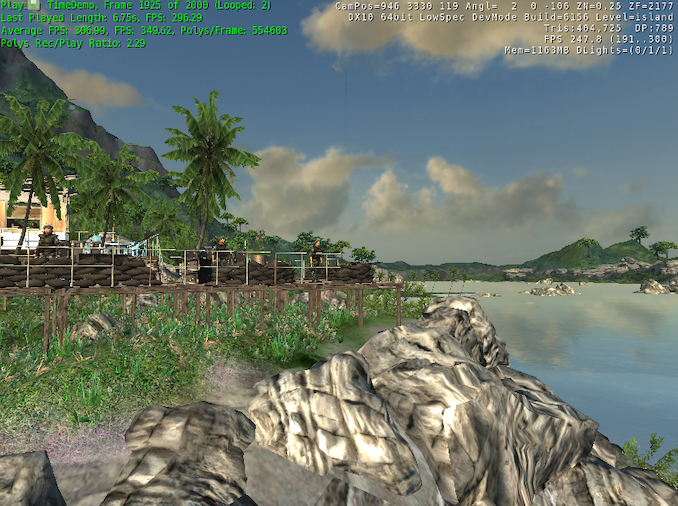
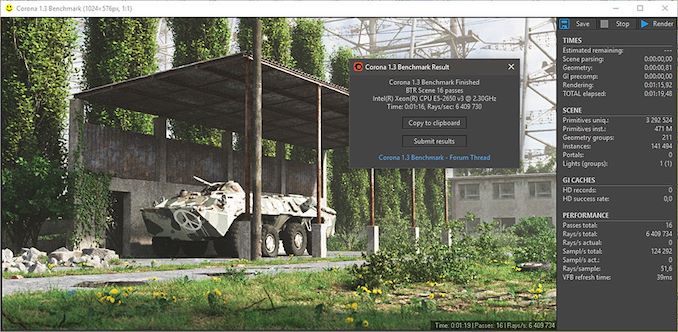








220 Comments
View All Comments
Darkworld - Wednesday, May 20, 2020 - link
10500k?Chaitanya - Wednesday, May 20, 2020 - link
Pointless given R5 3000 family of CPUs.yeeeeman - Wednesday, May 20, 2020 - link
Yeah right. Except it will beat basically all and lineup in games. Otherwise it is pointless.yeeeeman - Wednesday, May 20, 2020 - link
All AMD lineup*SKiT_R31 - Wednesday, May 20, 2020 - link
Yeah with a 2080 Ti the flagship 10 series CPU beats AMD in most titles, generally by a single digit margin. Who is pairing a mid-low end CPU with such a GPU? Also if there were to be a 10500K, you probably don't need to look much further than the 9600K in the charts above.This may have been missed on you, but what CPU reviews like the above show is: unless you are running the most top end flagship GPU and are low resolution high fps gaming, AMD is better at every single price point. Just accept it, and move on.
Drkrieger01 - Wednesday, May 20, 2020 - link
It also means that if you have purchased an Intel 6th gen CPU in i5 or i7, there's not much reason to upgrade unless you need more threads. And it will only be faster if you're using those said threads effectively. I'm still running an i5 6600K, granted it's running at 4.6GHz - there's no reason for me to upgrade until either Intel and/or AMD come up with better architecture and frequency combination (IPC + clock speed).I'll likely be taking the jump back to AMD for the Ryzen 4000's after a long run since the Sandy Bridge era.
Anyone needing only 4-6 cores should wait until then as well.
Samus - Thursday, May 21, 2020 - link
That's most people, including me. I'm still riding my Haswell 4C/8T because for my applications the only thing more cores will get me is faster unraring of my porn.Lord of the Bored - Thursday, May 21, 2020 - link
Hey, that's an important task!Hxx - Wednesday, May 20, 2020 - link
at 1440p intel still leads in gaming. It may not lead by much or may not lead by enough to warranty buying it over Intel but the person buying this chip is rocking a high end gpu and will likely upgrade to a high end gpu and the performance gap will only widen in intel's favor as the gpu becomes less of a bottleneck. So yeah pairing this with a 2060 makes no sense, go AMD. but pairing this with a 2080ti and a soon to be released 3080TI oh yeah this lineup will be a better choice.DrKlahn - Thursday, May 21, 2020 - link
By that logic the new games released since the Ryzen 3x000 series debut last year should show a larger gap at 1440+ between Intel and AMD. But they don't. And judging by past trends I doubt they will in the future either.As GPUs advance so does the eye candy in the newer engines, keeping the bottleneck pretty much where it always is at higher resolutions and detail levels, the GPU.